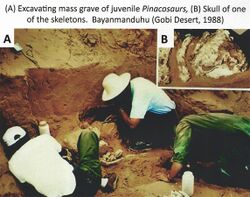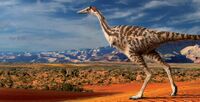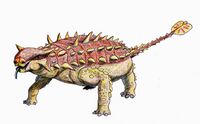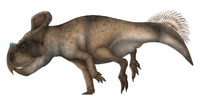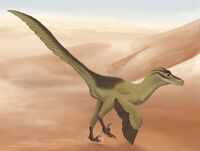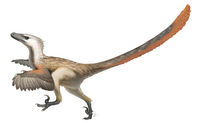The Bayan Mandahu Formation (also known as Wulansuhai Formation or Wuliangsuhai Formation) is a geological unit of "redbeds" located near the village of Bayan Mandahu in Inner Mongolia, China Asia (Gobi Desert) and dates from the late Cretaceous Period. Laid down in the Campanian, it is dated somewhat uncertainly to between 75 and 71 mya (million years ago).[1]
Description
The paleoenvironment it preserves was semi-arid and characterized by alluvial (stream-deposited) and eolian (wind-deposited) sediments. The formation is known for its vertebrate fossils, most of which are preserved in unstructured sandstone, indicating burial by wind-blown sandstorms.[2]
Paleofauna of the Bayan Mandahu Formation
The fauna of the Bayan Mandahu is very similar in composition to the nearby Djadochta Formation, and the two may have been deposited at roughly the same time. These two formations share many of the same genera, but differ in the makeup of species. For example, the most common mammal in the Djadochta is Kryptobaatar dashzevegi, while in the Bayan Mandahu, it is the closely related Kryptobaatar mandahuensis. Similarly, the dinosaur fauna of the Djadochta includes Protoceratops andrewsi and Velociraptor mongoliensis, while the Bayan Mandahu contains Protoceratops hellenikorhinus and Velociraptor osmolskae.[1]
Crocodylomorphs
Lizards
An amphisbaenian species is known from the formation.[2] An iguanian species is known from the formation.[2]
Turtles
| Turtles of the Bayan Mandahu Formation
|
| Genus
|
Species
|
Location
|
Material
|
Notes
|
Images
|
| Basilemys[2]
|
|
|
|
A softshell turtle.
|
|
| "Zangerlia"
|
"Z." neimongolensis
|
Bayan Mandahu
|
"Partial to complete skeletons of multiple individuals."[3]
|
A nanhsiungchelyid.
|

|
Mammals
A taeniolabidoidea multituberculate is known from the formation.[2]
Dinosaurs
Alvarezsaurs
| Genus |
Species |
Location |
Material |
Notes |
Images
|
| Alvarezsauridae indet.[5]
|
Indeterminate[5]
|
Bayan Mandahu[5]
|
An articulated series of partial anterior cervical vertebrae, an anterior cervical vertebra, isolated fragmentary anterior caudal vertebrae, a partial scapula, and pedal phalanges.[5]
|
An unnamed parvicursorine alvarezsaurid.[5]
|
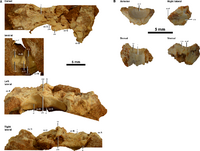
|
| Linhenykus
|
L. monodactylus[6]
|
Wuliangsuhai [6]
|
Cervical vertebrae, dorsal vertebrae, sacral vertebrae, caudal vertebrae, a scapulocoracoid, a sternum, much of the forelimbs, a partial pelvis, nearly complete hindlimbs, and some unidentified fragments.[6]
|
A monodactyl parvicursorine alvarezsaurid.[6]
|
|
Ankylosaurs
| Genus |
Species |
Location |
Material |
Notes |
Images
|
| Pinacosaurus
|
P. grangeri[7]
|
Bayan Mandahu[7]
|
[Four] juvenile specimens consisting of skulls, manidibles, cervical half-rings and almost complete skeletons, and an incomplete subadult skull.[7]
|
A basal ankylosaurine ankylosaurid also known from the Djadochta Formation.
|
|
| P. mephistocephalus[8]
|
Bayan Mandahu[8]
|
A nearly complete articulated skeleton, with in situ cervical dermal armour and tail-club, that lies in a natural with limb bones doubled under the body.[8]
|
A basal ankylosaurine ankylosaurid.
|
|
Birds
| Genus |
Species |
Location |
Material |
Notes |
Images
|
| cf. Gobipteryx
|
Indeterminate
|
|
"Eggs similar to those attributed to Gobipteryx minuta from the Djadochta Formation."[2]
|
|
|
Ceratopsians
| Genus |
Species |
Location |
Material |
Notes |
Images
|
| Genus
|
Species
|
Location
|
Material
|
Notes
|
Images
|
| Bagaceratops
|
B. rozhdestvenskyi
|
Bayan Mandahu
|
A partial skull.[9]
|
A protoceratopsid also known from the Barun Goyot Formation and possibly the Djadochta Formation.
|

|
| Magnirostris[1]
|
M. dodsoni[1]
|
Bayan Mandahu[10]
|
A partial skull.
|
A protoceratopsid now considered synonym of Bagaceratops.[9]
|
|
| Protoceratops
|
P. hellenikorhinus[11]
|
Bayan Mandahu[11]
|
Skulls and sparse body remains from multiple individuals.[12][11]
|
A protoceratopsid.
|
|
| Udanoceratops?
|
Indeterminate
|
Bayan Mandahu
|
"Nearly 1 meter long skull."[2]
|
A giant leptoceratopsid. Reported remains probably represent Protoceratops hellenikorhinus.[13]
|
|
Dromaeosaurs
| Genus |
Species |
Location |
Material |
Notes |
Images
|
| Linheraptor[14]
|
L. exquisitus[14]
|
Wuliangsuhai[14]
|
A skull, cervical vertebrae, caudal vertebrae, a scapula, a humerus, a radius, metacarpals, manual phalanxes, sternal plate, a pubis, a femur, a tibiotarsus, metatarsals, and pedal phalanxes.[14]
|
A possible velociraptorine dromaeosaurid.[14]
|
|
| Velociraptor
|
V. osmolskae[15]
|
Bayan Mandahu[1]
|
A paired maxillae and left lacrimal.[1]
|
A velociraptorine dromaeosaurid.[1]
|
|
Hadrosaurs
| Genus |
Species |
Location |
Material |
Notes |
Images
|
| Undescribed Hadrosauridae[10]
|
Indeterminate[10]
|
Bayan Mandahu[10]
|
|
A hadrosaurid.
|
|
Oviraptorosaurs
| Genus |
Species |
Location |
Material |
Notes |
Images
|
| Machairasaurus
|
M. leptonychus[10]
|
Bayan Mandahu[10]
|
A nearly complete articulated right forearm and manus, pedal phalanges, manual phalanges, caudal vertebrae, dorsal ribs, chevrons, and fragments of metatarsals III and IV.[10]
|
A heyuanniine oviraptorid.[10]
|
|
| Oviraptoridae indet.
|
Indeterminate
|
Bayan Mandahu
|
"Partial individual sitting atop an egg clutch."[16]
|
An oviraptorid that represent the second nesting oviraptorid. Sometimes referred to Machairasaurus.[10][17]
|
|
| Wulatelong
|
W. gobiensis[18]
|
Wuliangsuhai[18]
|
A partial skull, dorsal vertebrae, caudal vertebrae, partial scapulocoracoids, a partial sternum, a partial humerus, an incomplete manus, a nearly complete pelvic girdle, and the right hindlimb.[18]
|
A basal oviraptorid oviraptorosaur.[18]
|
|
Sauropods
| Genus |
Species |
Location |
Material |
Notes |
Images
|
| Undescribed Sauropoda[10]
|
Indeterminate[10]
|
Bayan Mandahu[10]
|
|
A sauropod.
|
|
Troodontids
| Genus |
Species |
Location |
Material |
Notes |
Images
|
| Linhevenator[19]
|
L. tani[19]
|
Wuliangsuhai[19]
|
A skull and mandible, anterior dorsal vertebrae, middle dorsal vertebrae, a scapula, a humerus, incomplete ischia, a femur, nearly complete pes, and other fragmentary bones.[19]
|
A troodontid with short forearms.[19]
|
|
| Papiliovenator
|
P. neimengguensis[20]
|
Bayan Mandahu[20]
|
An almost complete skull, cervical vertebrae, anterior dorsal vertebrae, partial scapulae, partial coracoid, fragmentary pelvic girdle, partial humeri, ulna, radius, partial manus, femur, tibia, fibula, pes, and a pedal phalanx II-3.[20]
|
A troodontid that is part of a clad that includes all other Late Cretaceous troodontids except Almas.[20]
|
|
| Philovenator
|
P. curriei[21]
|
Wuliangsuhai[21]
|
A nearly complete femur, a partial tibia, a partial fibula, astragalus-calcaneum complex, distal tarsals, metatarsals, and pedal phalanges.[21]
|
A troodontid.[21]
|
|
Tyrannosaurs
See also
References
- ↑ 1.0 1.1 1.2 1.3 1.4 1.5 1.6 1.7 Godefroit, Pascal; Currie, Philip J.; Li Hong; Shang Chang Yong; Dong Zhi-ming (2008). "A new species of Velociraptor (Dinosauria: Dromaeosauridae) from the Upper Cretaceous of northern China". Journal of Vertebrate Paleontology 28 (2): 432–438. doi:10.1671/0272-4634(2008)28[432:ANSOVD2.0.CO;2].
- ↑ 2.00 2.01 2.02 2.03 2.04 2.05 2.06 2.07 2.08 2.09 2.10 2.11 2.12 2.13 Jerzykiewicz, T.; Currie, P. J.; Eberth, D. A.; Johnston, P. A.; Koster, E. H.; Zheng, J.-J. (1993). "Djadokhta Formation correlative strata in Chinese Inner Mongolia: an overview of the stratigraphy, sedimentary geology, and paleontology and comparisons with the type locality in the pre-Altai Gobi". Canadian Journal of Earth Sciences 30 (10): 2180−2195. doi:10.1139/e93-190. Bibcode: 1993CaJES..30.2180J. https://www.researchgate.net/publication/237174446.
- ↑ Brinkman, D. B.; Tong, H.-Y.; Li, H.; Sun, Y.; Zhang, J.-S.; Godefroit, P.; Zhang, Z.-M. (2015). "New exceptionally well-preserved specimens of "Zangerlia" neimongolensis from Bayan Mandahu, Inner Mongolia, and their taxonomic significance". Comptes Rendus Palevol 14 (6–7): 577−587. doi:10.1016/j.crpv.2014.12.005.
- ↑ John R. Wible; Sarah L. Shelley; Shundong Bi (2019). "New Genus and Species of Djadochtatheriid Multituberculate (Allotheria, Mammalia) from the Upper Cretaceous Bayan Mandahu Formation of Inner Mongolia". Annals of Carnegie Museum 85 (4): 285–327. doi:10.2992/007.085.0401. https://www.researchgate.net/publication/338202993.
- ↑ 5.0 5.1 5.2 5.3 5.4 Pittman, M.; Xu, X.; Stiegler, J. B. (2015). "The taxonomy of a new parvicursorine alvarezsauroid specimen IVPP V20341 (Dinosauria: Theropoda) from the Upper Cretaceous Wulansuhai Formation of Bayan Mandahu, Inner Mongolia, China". PeerJ 3: e986. doi:10.7717/peerj.986. PMID 26082871.
- ↑ 6.0 6.1 6.2 6.3 Xu, Xing; Sullivan, Corwin; Pittman, Michael; Choiniere, Jonah N.; Hone, David W.E.; Upchurch, Paul; Tan, Qingwei; Xiao, Dong et al. (2011). "A monodactyl nonavian dinosaur and the complex evolution of the alvarezsauroid hand". Proceedings of the National Academy of Sciences of the United States of America 108 (6): 2338–2342. doi:10.1073/pnas.1011052108. PMID 21262806. Bibcode: 2011PNAS..108.2338X.
- ↑ 7.0 7.1 7.2 Burns, Michael; Arbour, Victoria; Sissons, Robin; Currie, Philip (2011). "Juvenile specimens of Pinacosaurus grangeri Gilmore, 1933 (Ornithischia: Ankylosauria) from the Late Cretaceous of China, with comments on the specific taxonomy of Pinacosaurus". Cretaceous Research 32 (2011): 174–186. doi:10.1016/j.cretres.2010.11.007.
- ↑ 8.0 8.1 8.2 Godefroit, P.; Pereda-Suberbiola, X.; Li, H.; Dong, Z. M. (1999). "A new species of the ankylosaurid dinosaur Pinacosaurus from the Late Cretaceous of Inner Mongolia (P.R. China)". Bulletin de l'Institut Royal des Sciences Naturelles de Belgique, Sciences de la Terre 69 (supp. B): 17–36. http://biblio.naturalsciences.be/rbins-publications/bulletin-of-the-royal-belgian-institute-of-natural-sciences-earth-sciences/69-sup-b-1999/bulletin69supb-article2.pdf.
- ↑ 9.0 9.1 Czepiński, Ł. (2019). "Ontogeny and variation of a protoceratopsid dinosaur Bagaceratops rozhdestvenskyi from the Late Cretaceous of the Gobi Desert". Historical Biology 32 (10): 1394–1421. doi:10.1080/08912963.2019.1593404. http://dinosaurmailinglist.cmnh.org/2019Apr/pdfzmfpMk1aO4.pdf. Retrieved 2021-03-03.
- ↑ 10.00 10.01 10.02 10.03 10.04 10.05 10.06 10.07 10.08 10.09 10.10 10.11 10.12 10.13 10.14 Nicholas R. Longrich; Philip J. Currie; Dong Zhi-Ming (2010). "A new oviraptorid (Dinosauria: Theropoda) from the Upper Cretaceous of Bayan Mandahu, Inner Mongolia". Palaeontology 53 (5): 945–960. doi:10.1111/j.1475-4983.2010.00968.x.
- ↑ 11.0 11.1 11.2 Lambert, O.; Godefroit, P.; Li, H.; Shang, C.-Y.; Dong, Z. (2001). "A new Species of Protoceratops (Dinosauria, Neoceratopsia) from the Late Cretaceous of Inner Mongolia (P. R. China)". Bulletin de l'Institut Royal des Sciences Naturelles de Belgique, Sciences de la Terre 71: 5−28. http://biblio.naturalsciences.be/rbins-publications/bulletin-of-the-royal-belgian-institute-of-natural-sciences-earth-sciences/71-sup-2001/irscnb_p4087_01ec08x_71-sup_bulletin-1.pdf.
- ↑ "Occurrence of Protoceratops hellenikorhinus (Ceratopsia: Protoceratopsidae) in Alxa region, western Inner Mongolia, China". Acta Geologica Sinica 96 (11): 3722–3732. 2022. doi:10.19762/j.cnki.dizhixuebao.2022302. http://www.geojournals.cn/dzxb/ch/reader/view_abstract.aspx?file_no=2022427.
- ↑ Czepiński, Ł. (2020). "New protoceratopsid specimens improve the age correlation of the Upper Cretaceous Gobi Desert strata". Acta Palaeontologica Polonica 65 (3): 481−497. doi:10.4202/app.00701.2019. http://www.app.pan.pl/archive/published/app65/app007012019.pdf.
- ↑ 14.0 14.1 14.2 14.3 14.4 Xu, Xing; Choiniere, Jonah N.; Pittman, Michael; Tan, Qingwei; Xiao, Dong; Li, Zhiquan; Tan, Lin; Clark, James M. et al. (2010-03-19). "A new dromaeosaurid (Dinosauria: Theropoda) from the Upper Cretaceous Wulansuhai Formation of Inner Mongolia, China" (in en). Zootaxa 2403 (1): 1–9. doi:10.11646/zootaxa.2403.1.1. ISSN 1175-5334.
- ↑ Godefroit, Pascal; Currie, Philip J.; Li, Hong; Shang, Chang Yong; Dong, Zhi-ming (2008). "A new species of Velociraptor (Dinosauria: Dromaeosauridae) from the Upper Cretaceous of northern China". Journal of Vertebrate Paleontology 28 (2): 432–438. doi:10.1671/0272-4634(2008)28[432:ANSOVD2.0.CO;2].
- ↑ Dong, Z.; Currie, P. J. (1996). "On the discovery of an oviraptorid skeleton on a nest of eggs at Bayan Mandahu, Inner Mongolia, People's Republic of China". Canadian Journal of Earth Sciences 33 (4): 631−636. doi:10.1139/e96-046. Bibcode: 1996CaJES..33..631D.
- ↑ Fanti, F.; Currie, P. J.; Badamgarav, D.; Lalueza-Fox, C. (2012). "New specimens of Nemegtomaia from the Baruungoyot and Nemegt Formations (Late Cretaceous) of Mongolia". PLOS ONE 7 (2): e31330. doi:10.1371/journal.pone.0031330. PMID 22347465. Bibcode: 2012PLoSO...731330F.
- ↑ 18.0 18.1 18.2 18.3 Xu Xing; Tan Qing-Wei; Wang Shuo; Corwin Sullivan; David W. E. Hone; Han Feng-Lu; Ma Qing-Yu; Tan Lin et al. (2013). "A new oviraptorid from the Upper Cretaceous of Nei Mongol, China, and its stratigraphic implications". Vertebrata PalAsiatica 51 (2): 85–101. http://www.ivpp.cas.cn/cbw/gjzdwxb/xbwzxz/201305/P020130507385115746165.pdf.
- ↑ 19.0 19.1 19.2 19.3 19.4 Xu, Xing; Tan, Qingwei; Sullivan, Corwin; Han, Fenglu; Xiao, Dong (2011-09-07). "A Short-Armed Troodontid Dinosaur from the Upper Cretaceous of Inner Mongolia and Its Implications for Troodontid Evolution". PLOS ONE 6 (9): e22916. doi:10.1371/journal.pone.0022916. ISSN 1932-6203. PMID 21915256. Bibcode: 2011PLoSO...622916X.
- ↑ 20.0 20.1 20.2 20.3 Pei, R.; Qin, Yuying; Wen, Aishu; Zhao, Q.; Wang, Z.; Liu, Z.; Guo, W.; Liu, P. et al. (2021). "A New Troodontid from the Upper Cretaceous Gobi Basin of Inner Mongolia, China". Cretaceous Research 130: Article 105052. doi:10.1016/j.cretres.2021.105052.
- ↑ 21.0 21.1 21.2 21.3 Xu Xing; Zhao Ji; Corwin Sullivan; Tan Qing-Wei; Martin Sander; Ma Qing-Yu (2012). "The taxonomy of the troodontid IVPP V 10597 reconsidered". Vertebrata PalAsiatica 50 (2): 140–150. http://www.ivpp.cas.cn/cbw/gjzdwxb/xbwzxz/201204/P020120423369968204026.pdf.
Bibliography
- Weishampel, David B.; Peter Dodson, and Halszka Osmólska (eds.). 2004. The Dinosauria, 2nd edition, 1–880. Berkeley: University of California Press. Accessed 2019-02-21. ISBN:0-520-24209-2
 | Original source: https://en.wikipedia.org/wiki/Bayan Mandahu Formation. Read more |
